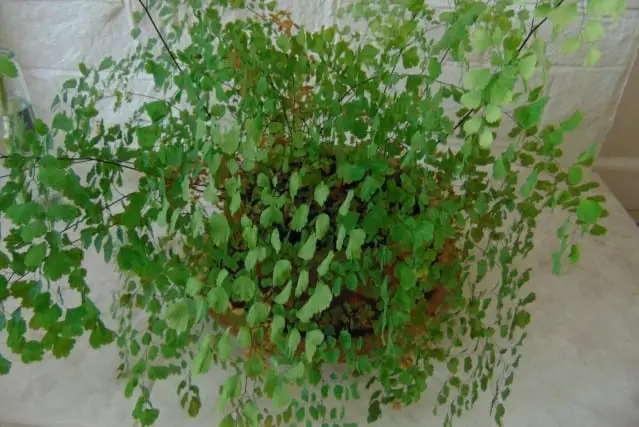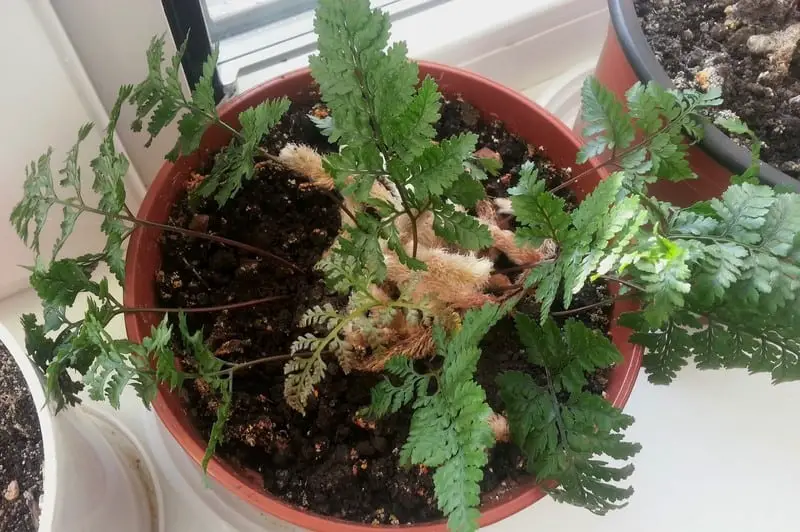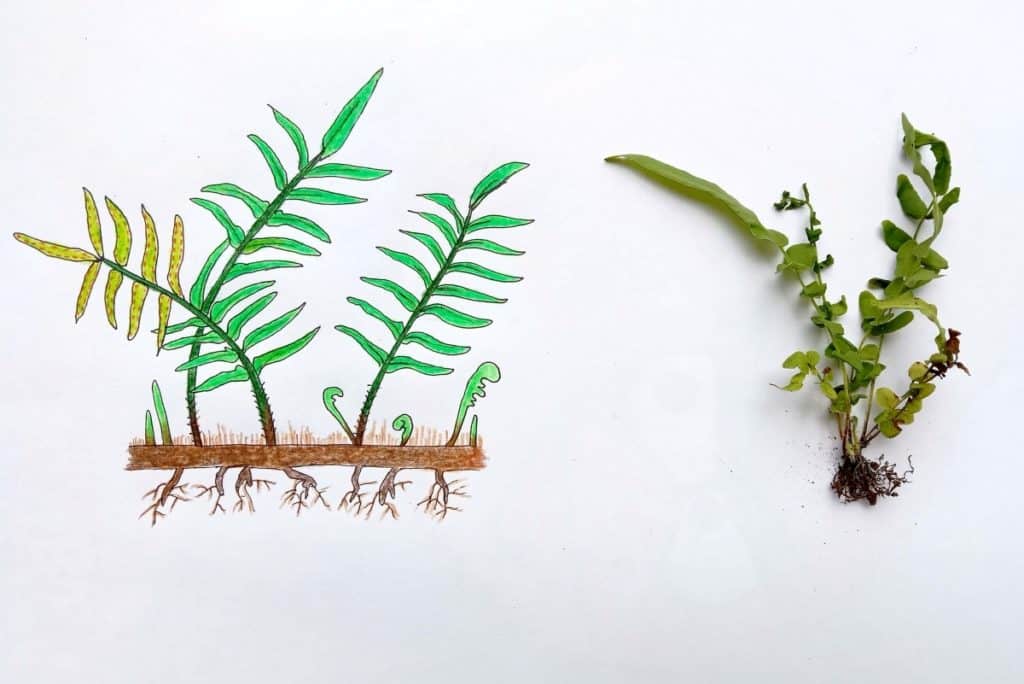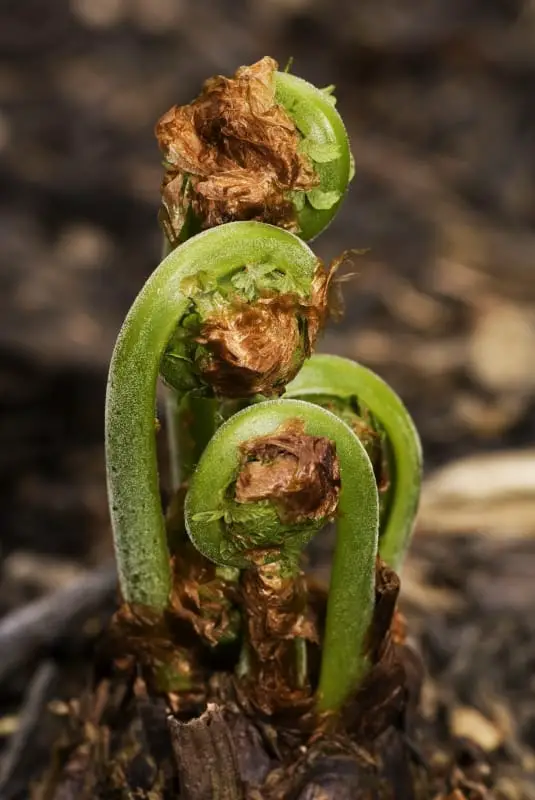Sometimes, despite our best efforts, ferns can wilt, sicken or turn brown. It’s not always easy to know if this means the plant is lost for good or whether there is a still chance you could save it. So, how do you find out for sure whether your fern is dead?
Ferns can recover from stress as long as the growth zone in the rhizome and roots is healthy. A fern is only dead when this part of the plant has been damaged or decayed beyond repair. Ferns can be revived even after losing all their fronds to sun damage, wilting or browning – the trick is to check the roots and rhizome carefully, and replant the fern with minimal stress to give it the best chance of bouncing back.
There are many reasons why a fern may die back, and establishing what caused the problem in the first place will be essential to find out whether you can recover the plant. The best strategy for checking for health and for helping the plant recover will depend on what caused the damage, whether the fern is indoors or out, and the needs of the specific variety of fern. Here are the best questions to ask to figure out whether your plant can be saved.
1. Is it a deciduous variety?
It might seem obvious, but the first thing to check is whether the die-back is a part of the seasonal cycle of a deciduous fern. Most popular indoor varieties are evergreen, but plants in the yard may have simply started to lose foliage in fall and turn brown as a natural process. If you aren’t sure, review the list of ferns to find out, or check with a local specialist.
If this is the issue, then all you have to do is wait for the next spring growth season and your fern will bounce back.
2. Are there any signs of pest infestation?
Another possible cause of deterioration is pest damage. On the whole, ferns are pretty resilient to pests, and certainly less prone to them than most flowering plants.

However, there are some insects like scale insect, mealy bugs and fern mites that can affect the plant. It is rare for an infestation to kill the plant, so if your fern is suffering from stunted growth of fronds or wilting, then it should be isolated until you can kill the pests with organic methods or with insecticide.
Once the infestation is eliminated, the fern should bounce back strongly.
3. Is it getting too much sun?
While some ferns can grow happily in the sun, most prefer partial or full shade. Signs of excessive sun are pale, bleached looking fronds, or brittle, papery fronds.
It is unlikely that too much sun will kill the fern unless it is a prolonged stress, or accompanied by drought. The simple solution to sun damage is to relocate the fern – moving the pot away from windows for an indoor plant, or replanting to a sheltered, shady part of the yard for outdoor ferns.
4. Have you underwatered?
Another serious risk with ferns is drought. Some varieties can tolerate dry spells, but most need moist conditions. If the soil around the fern is very dry, give the fern a good watering, but take it in stages, allowing the water to fully soak in before topping up the soil.
Drought can be one of the causes of losing the plant for good. The only way to be sure is to continue to water conscientiously, while taking steps to avoid overwatering. It is worth topping the soil with a stones or mulch to help retain moisture near the superficial roots and rhizome to maximize the chance of recovery.
Then, it is a question of waiting patiently for a couple of weeks to discover whether the growth zone in the rhizome is still alive.
5. Are there signs of rot?
One of the commonest problems with fern health is overwatering. The particular risk is root rot, which occurs when bacteria or fungi can infect waterlogged roots that have been drowned, but dead fronds can also be a site in which an infection can get established.
Indications of overwatering are soggy, poorly draining soil, a heavy pot to lift, or an unpleasant smell. There are simple steps that can be taken to rescue an overwatered fern, but the best way to find out if the plant can be recovered is to directly assess the extent of the damage.
Remove the plant from it’s pot, and look at the condition of the roots. Mushy, black roots are dead and decaying. If this is widespread, and has also reached the rhizome, then the plant may not recover.
The best bet is to repot in fresh potting mix, and take care to manage the drainage and watering carefully until the plant has had a chance to grow new roots and recover.
6. Are there any special conditions for the variety?
A final possibility is that a particular variety of fern needs some special conditions that aren’t being met. Some ferns will only grow well in acid soil, and others in alkaline soil. Planting in the wrong conditions will lead to stunted growth. Check our list of ferns to find the preference for each variety.
Some ferns react badly to sudden changes in temperature, such as being brought in from the outside, or being placed next to a radiator in the house. Maidenhair and Boston ferns are known to suffer shock from a sudden change in environmental conditions, and will need some close attention if this happens.

Maidenhair fern
- Adiantum raddianum
- Evergreen
- Partial shade
- Height: up to 0.5 m
- Soil: neutral or alkaline. Moist, well-drained.

Boston fern
- Nephrolepis exaltata
- Evergreen
- Partial shade
- Height: up to 1 m
- Soil: acid or neutral. Moist, well-drained.
If the problem of mismatched soil or environment can be identified and solved, the fern is likely to recover well.
7. How to tell if your fern is still alive
After managing any pest, light, environmental or watering problems, it will take some time before the fern will show signs of recovery. The only way to know for certain if your fern is still alive, is to set up optimal conditions for recovery and then wait to see if new growth appears. The time needed will depend on the time of year, with recovery likely to be most rapid in the spring (especially for deciduous ferns).
New fronds will emerge from the rhizome – the stem of the fern from which both roots and fronds grow. This is where you would need to look for signs of life, but with care! It is important not to disturb or damage the rhizome when trying to assess the state of the plant.
For most ferns, the rhizomes lie under the soil but some varieties like the Rabbit’s foot and Kangaroo paw ferns have visible rhizomes on the surface.

Rabbit’s foot fern
- Davallia solida (var. fejeensis)
- Evergreen
- Partial shade
- Height: up to 1 m
- Soil: acid or neutral. Moist, well-drained.

Kangaroo paw fern
- Microsorum diversifolium
- Evergreen
- Prefers partial shade
- Height: up to 0.5 m
- Soil: acid or neutral. Moist, well-drained.
The rhizome projects roots down into the soil, and new fiddleheads up into the air. Here is a picture of the basic anatomy:

For ferns that grow as crowns, the rhizomes will be tightly packed together with a thicket of fronds emerging from the top. This structure is known as the “caudex” and is where you need to look for signs of new growth.
Ultimately, you will know for sure that your fern has survived it’s trial if new green shoots begin to project from the soil.

Although many stresses can cause discoloration or loss of fronds in ferns, the plant will only be damaged beyond recovery if the rhizome is killed. By taking steps to eliminate the cause of the stress, you will give it the best chance for recovery. Really, the only way to know for sure whether your fern is dead is to provide the best conditions you can, and then wait patiently for the spring growing season, when you will find out once and for all.
Related: If you are struggling with fern maintenance, it’s worth checking out this list of the easiest ferns to grow.
